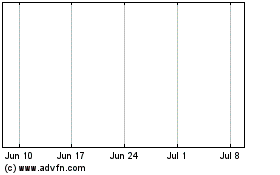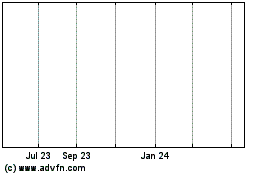By Timothy W. Martin
Samsung Electronics Co. unveiled its latest flagship smartphone
Wednesday, hoping extra variety with the new Galaxy Note 10 device
attracts consumers who aren't so likely anymore to want the same
new thing.
The debut in New York City, before a partisan crowd, followed a
familiar script for a familiar-looking device. But the event
prompts a question: How much magnetism is left with a
top-of-the-line smartphone?
Samsung's newest premium handsets, once its dominant growth
driver, now make up just one-quarter of the company's total
shipments, as affluent consumers see fewer reasons to upgrade. At
the same time, the new Galaxy Note 10 arrives at a pivotal moment
with a significant opportunity. As U.S. restrictions slow rival
Huawei Technologies Co., Samsung can woo back buyers who had left
for the Chinese rival.
Samsung, the world's largest smartphone maker, launched the
Galaxy Note 10 at Brooklyn's Barclays Center. For the first time,
the South Korean technology giant chose to offer two sizes of the
phone, with screens measuring diagonally at 6.3 inches and 6.8
inches respectively. The phone is also equipped with new camera
tricks. "The Galaxy Note 10 delivers the speed and productivity you
need," said D.J. Koh, Samsung's mobile chief, at the event.
The extra choice reflects an existential crisis rippling across
the broader smartphone industry. Manufacturers could once bank on
consumers gobbling up whatever new release they were offered --
typically in a single model sold at a hefty price. But that era has
passed, with consumers showing resistance to prices nudging past
$1,000. Industry sales have tumbled.
"These events appeal to fewer and fewer people," said Cliff
Maldonado, a senior analyst at BayStreet Research LLC, which tracks
device sales. With more frequency, sales of the high-end models
fade after the first 45 days, following an initial bump from
enthusiasts, he added.
The two variants of the Galaxy Note 10 implement the types of
advances expected with a new release. They are slimmer and more
powerful, packing more robust processors and batteries. Using
Samsung's "Infinity-O" display, the typically off-center,
front-facing camera finds itself now at the top-middle of the
phone. Both models ditch the earphone jack.
The Galaxy Note 10 also syncs with personal computers running on
Microsoft Corp.'s Windows 10 operating system. This allows users to
field text messages or access smartphone photos on a computer.
Phones known as flagships, such as the Galaxy Note 10, have
historically juiced sales for Samsung and rival Apple Inc. They
fetch the highest prices, fuel brand image and notch the biggest
profits.
Last year, Samsung sold three versions of such devices: two
Galaxy S phones and a single Galaxy Note model.
This year, the number will balloon to seven when Samsung adds a
third flagship device. Next month, the company plans to introduce
the Galaxy Fold, the mainstream industry's first foldable-screen
phone. The nearly $2,000 device folds in half like a book and, when
opened, unfurls to the size of a small tablet.
The Galaxy Fold will join the two Galaxy Note 10 variants and
four models of the Galaxy S10 in Samsung's stable of flagships.
Experts warned that Samsung's expanded library risks
cannibalizing the company's overall sales, as some buyers can
upgrade to a new device at a lower price point than previously
offered. "The whole Samsung premium tier is getting quite crowded,"
said Wayne Lam, an industry analyst at research firm IHS Markit, a
market researcher.
Handset makers are searching for answers, as global shipments
slid 2% from the prior year for the three months ended June 30,
according to Canalys, a market researcher.
Canalys said Samsung, which had posted sales declines over the
past year, reported a 6% boost driven mostly by growth from its
midtier lineups, as the South Korean firm benefited from Huawei's
stumbles outside China. Although revenue rose, Samsung said last
week that its operating profit sank 42% from the prior year, the
result of promotions required to boost sales.
A more tiered approach is seen elsewhere across the industry, as
buyers show a willingness to forego extra horsepower for a more
affordable price.
Apple's most recent offerings include the lower-cost iPhone XR
model that outsold two pricier versions. In May, Alphabet Inc.'s
Google started selling the Pixel 3A phone, offered at half the
price of the Pixel 3, which helped drive a doubling in unit sales
during the latest quarter. Samsung's own Galaxy S10 rollout earlier
this year included a pared-down S10e variant.
New flagship phones, in their first year of sales, have
constituted a smaller share of Samsung's total shipments in recent
years. As recently as five years ago, the premium devices
represented the majority of phones sold, according to International
Data Corp., a market researcher. But the ratio has fallen to just
26% this year, IDC said.
"There is a loss of that halo around their flagship phones
versus the past," said Ryan Reith, an IDC research vice
president.
The Galaxy Note series was the first mainstream plus-size phone
when it made its debut about eight years ago, winning a loyal fan
base with its S Pen stylus. But it ran into controversy in 2016,
when Samsung was forced to issue a global recall of Galaxy Note 7
devices over faulty batteries that caused some devices to catch
fire. The incident cost the company roughly $6.5 billion.
Preorders for the Galaxy Note 10 start Thursday, with the
devices hitting shelves in select markets on Aug. 23.
Samsung said the base model of the Galaxy Note 10, with 256
gigabytes of memory, would be priced at $949 in the U.S. -- a $50
reduction from the prior year. The larger Galaxy Note 10+ starts at
$1,099 in the U.S., with a 5G version available initially through
Samsung's website and Verizon Communications Inc.
Write to Timothy W. Martin at timothy.martin@wsj.com
(END) Dow Jones Newswires
August 07, 2019 18:07 ET (22:07 GMT)
Copyright (c) 2019 Dow Jones & Company, Inc.
Samsung Electronics (PK) (USOTC:SSNHZ)
Historical Stock Chart
From Mar 2024 to Apr 2024

Samsung Electronics (PK) (USOTC:SSNHZ)
Historical Stock Chart
From Apr 2023 to Apr 2024
